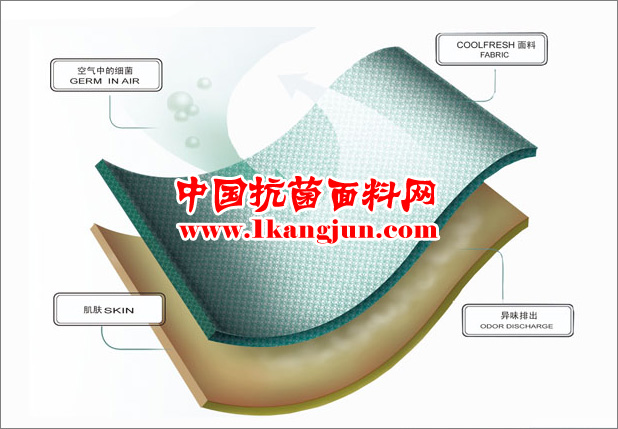Technical development of antibacterial functional fabrics
In general, antibacterial functional fabrics can be achieved through two technical approaches, using functional finishing methods and direct use of antimicrobial fibers. The method of functional finishing can achieve the purpose of antibacterial, although it is convenient, but the chemical finishing will affect the style and feel of the fabric. Therefore, the direct research and development of antibacterial textiles using antibacterial fibers is the key development direction.
Â
The antibacterial fibers selected in this paper are nano silver antibacterial polyester fiber, natural antibacterial chitin fiber, bamboo fiber and bamboo carbon fiber. In order to investigate the antibacterial properties of various antibacterial fibers, special fabric samples were tested and their antibacterial properties were tested and compared. The relationship between antibacterial materials and antibacterial properties was studied. The test for anti-caries efficacy was carried out according to national standards using a oscillating flask method, and the test species were Escherichia coli and Staphylococcus aureus.
Â

1 Introduction to antibacterial performance test methods
Antibacterial fabrics have a special quality test indicator, namely the anti-emulsion effect. Determination of antibacterial efficacy A number of evaluation experiments have been proposed at home and abroad, but these methods have some defects, and the scope of application has certain limitations. Antibacterial agents can be broadly divided into two types: dissolution type ( antibacterial agent on fabric can be slowly dissolved in water ) and non-dissolution type ( antibacterial agent and fiber combination, insoluble ) . The corresponding representative antibacterial performance test methods are: The Experimental Method for Antibacterial Properties of Fabrics as stipulated in the National Standards of the People's Republic of China GBl5979 - 2002 "Sanitary Standards for Disposable Hygienic Articles", also known as "Oscillating Flask Method", is applicable to textiles produced from non-dissolving antibacterial agents.
Â
The antibacterial polyester fiber, bamboo fiber, chitin and bamboo carbon fiber selected in this subject are non-dissolving type, so the oscillating flask method is used for testing.
Â
2 antibacterial fabric antibacterial performance test
This experiment will test the antibacterial rate of nano-silver antibacterial polyester fabric, chitin fabric and bamboo fiber fabric, and evaluate the antibacterial properties of each fabric with ordinary polyester without anti-bacterial function.
Â
2 . 1 test principle
In the oscillating flask method, a certain concentration of the bacterial liquid is inoculated on the sample, and the contact between the antibacterial test substance and the test bacteria is increased by strong shaking for a long period of time, and the change in the number of colonies of the sample before and after the shaking is compared to evaluate the antibacterial property.
Â
2 . 2 test strains
Gram-positive bacteria: Staphylococcus aureus (ATCC25923) Gram-negative bacteria: Escherichia coli (ATCC25922)
Â
2 . 3 Calculation of inhibition rate
X=fA — B} / h × 100 % In the formula: X— one inhibition rate, %; A—the average number of colonies before the sample was shaken; B—the average number of colonies after the sample was shaken.
Â
2 . 4 evaluation criteria
The difference between the inhibition rate of the sample group and the inhibition rate of the control sample group was >26 %, and the product had an antibacterial effect.
Â
3 antibacterial performance test results and analysis
413 Proceedings of the 7th Symposium on Functional Textiles and Nanotechnology 200 % 4
Â
3 . 1 E. coli test results
In this paper, four sets of antibacterial typical fabrics were produced, and the raw material combinations and their structural parameters are shown in Table 1 . The results of the anti-E. coli performance test and analysis of these four antibacterial fabrics are shown. The antibacterial efficacy of each antibacterial fabric against Staphylococcus aureus was tested. The test and analysis results are shown in Table 3 , Table 4, and Pottery 4 , Figure 5 , and Figure 6 .
Table 1 Specimens of the test for the performance of the anti-infective performance. The number of colonies after the number of colonies before shaking was bacteriostatic, %
Inhibition rate difference, %
Comparison of anti-E. coli efficacy test results
Figure 2 Comparison of antibacterial rates of various antibacterial fabrics against E. coli. Proceedings of the 7th Symposium on Functional Textiles and Nanotechnology 20074
Â
3 . 2 Staphylococcus aureus test results
Â
Figure 3 Comparison of E. coli culture before and after
Â
Table 3 performance test results of anti-Staphylococcus aureus
Figure 4 Comparison of colonies before and after each antibacterial fabric Staphylococcus aureus
Figure 5 Comparison of antibacterial rates of Staphylococcus aureus against various anti-caries fabrics
415 bamboo carbon fiber ( front ) bamboo carbon fiber ( post )
FIG 6 S. aureus culture contrast to the situation before and after the test data in accordance with the comparison of the bacterial culture photographs case, each difference between the inhibition rate for antibacterial fabric of Staphylococcus aureus rather than national standard of 26%, shows good antibacterial properties
Â
Antibacterial functional fabric conclusion
(1) All four antibacterial fabrics have good antibacterial effects, meeting and exceeding the national standards for textiles with antibacterial properties.
(2) Antibacterial properties of antibacterial polyester fabric and chitin fabric are superior to bamboo fiber fabric.
(3) By properly selecting the raw materials, the non-pure antibacterial raw materials can also produce fabrics with good antibacterial effects and meeting the final use requirements.
ZeroClipboard.setMoviePath('/plugin/copytofriends/ZeroClipboard.swf'); var clip = new ZeroClipboard.Client(); clip.setHandCursor(true); clip.setText("Technological development of antibacterial functional fabrics http://"); clip.addEventListener('complete', function(client,text){ alert("Successfully copy this article to the clipboard!"); }); clip.glue('copytofriends') ;Poly Suede,Suede Textile,Stretch Suede Fabric,Perforated Suede Fabric
Shaoxing Qianhai Import and Export Co.,Ltd. , https://www.qhtextile.com